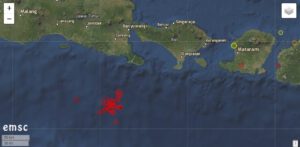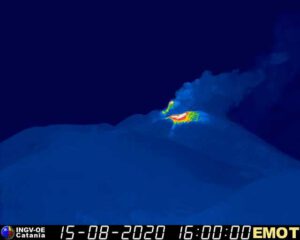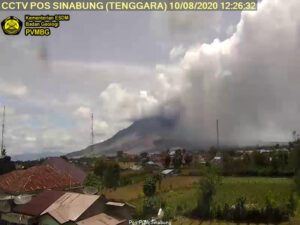 In Papua New Guinea the Kadovar volcano has become more active again. The small island volcano emits volcanic ash, which rises to an altitude of 1500 m. The volcano has been active again and again since January 2018, with major eruptions that changed the face of the island. For example, a lava dome grew on the east coast, which caused concern that it might collapse, causing a tsunami. Also this year, there were some bigger eruptions, but most of them took place under exclusion of the world public. Before the eruptions began, there was a small settlement on Kadovar. This was abandoned in the meantime and the inhabitants were resettled.
In Papua New Guinea the Kadovar volcano has become more active again. The small island volcano emits volcanic ash, which rises to an altitude of 1500 m. The volcano has been active again and again since January 2018, with major eruptions that changed the face of the island. For example, a lava dome grew on the east coast, which caused concern that it might collapse, causing a tsunami. Also this year, there were some bigger eruptions, but most of them took place under exclusion of the world public. Before the eruptions began, there was a small settlement on Kadovar. This was abandoned in the meantime and the inhabitants were resettled.
Month: August 2020
Bali: Earthquake south of the island
 Yesterday an earthquake of magnitude 5.1 manifested itself off the southern coast of the Indonesian islands of Bali and Java, with the hypocenter at a depth of 56 km. The earthquake triggered a series of aftershocks, which were at a much lower depth of 10 km. Most of the aftershocks have magnitudes in the range of 3. The earthquakes are associated with the subduction along the Sundab Arc and are not directly related to the volcanism in the region.
Yesterday an earthquake of magnitude 5.1 manifested itself off the southern coast of the Indonesian islands of Bali and Java, with the hypocenter at a depth of 56 km. The earthquake triggered a series of aftershocks, which were at a much lower depth of 10 km. Most of the aftershocks have magnitudes in the range of 3. The earthquakes are associated with the subduction along the Sundab Arc and are not directly related to the volcanism in the region.
A few hundred kilometres further east, similar events occurred in the Sumbawa region. Here, too, numerous earthquakes reduce stresses in the earth’s crust, which are caused by subduction along the Sunda Arc. It can be assumed that there are also tensions in the area between these two spots waiting to be relieved. At any time strong earthquakes can occur at the Sunda Arc, which could even trigger tsunamis.
Etna is getting hotter
 After ash emissions stopped yesterday afternoon, the volcano has resumed its activity today. Indeed, on the thermal cam you can see that the area around the saddle vent is hot and glowing tephra is being extracted. Ash is caught by the strong wind, pressed down and transported towards the northeast. The tremor fluctuates strongly at the border to the “red area”. The LGS maintains the pre-warning level “orange”. It already indicated an increase in activity 3 days ago. Under the Valle del Bove the number of weak earthquakes increased slightly again. Earthquake activity below the summit crater is unremarkable.
After ash emissions stopped yesterday afternoon, the volcano has resumed its activity today. Indeed, on the thermal cam you can see that the area around the saddle vent is hot and glowing tephra is being extracted. Ash is caught by the strong wind, pressed down and transported towards the northeast. The tremor fluctuates strongly at the border to the “red area”. The LGS maintains the pre-warning level “orange”. It already indicated an increase in activity 3 days ago. Under the Valle del Bove the number of weak earthquakes increased slightly again. Earthquake activity below the summit crater is unremarkable.
Sinabung erupted
 On the Indonesian island of Sumatra the Sinabung erupted again. The VAAC Darwin published a VONA message, after which volcanic ash rose to a height of 9800 m. The cloud drifted in a westerly direction. In time a second cloud reached a height of 4200 m and was multiplied in eastern direction.
On the Indonesian island of Sumatra the Sinabung erupted again. The VAAC Darwin published a VONA message, after which volcanic ash rose to a height of 9800 m. The cloud drifted in a westerly direction. In time a second cloud reached a height of 4200 m and was multiplied in eastern direction.
The volcanologists of Magma/VSI registered increased seismic activity the day before. Among the signals was a Tornillo. They detected the eruption in 2 signals with maximum amplitudes of 120 mm and 1785-2246 seconds duration. Although the eruption cloud rose higher than during the last eruption, there must not have been a much higher energy behind it. Weaker winds may have favoured the vertical rise of the volcanic ash to higher altitudes. The seismic signals indicate an eruption similar to the one on 8 August. In fact, the main eruption lasted longer than now.
The seismicity was increased in the first quarter of the day. There were 19 volcano-tectonic tremors recorded. Another Tornillo was also recorded. Tremor also occurred. In fact, it looks like the sinking has entered a new eruptive phase.
Erupsi #Sinabung 10 Agustus 2020 10.16WIB https://t.co/TuGNOVdDhe pic.twitter.com/EcTnTeSzxF
— MAGMA Indonesia (@id_magma) August 10, 2020